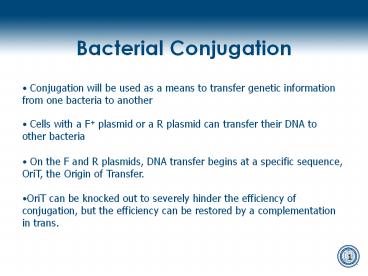Bacterial Conjugation - PowerPoint PPT Presentation
Title:
Bacterial Conjugation
Description:
The Tecan test shows that the key plasmid results in the recovery of fluorescence ... The controls show that conjugation is equivalent to a cotransformation of the ... – PowerPoint PPT presentation
Number of Views:2237
Avg rating:3.0/5.0
Title: Bacterial Conjugation
1
Bacterial Conjugation
- Conjugation will be used as a means to transfer
genetic information from one bacteria to another - Cells with a F plasmid or a R plasmid can
transfer their DNA to other bacteria - On the F and R plasmids, DNA transfer begins at
a specific sequence, OriT, the Origin of
Transfer. - OriT can be knocked out to severely hinder the
efficiency of conjugation, but the efficiency can
be restored by a complementation in trans.
2
OriT Complementation
3
Conjugation Assays
Matings with recipient cell ec100Dpir, which
is TriR, show if the F or R plasmid transfers by
the TriK plate and if an OriT plasmid transfers
by the TriA plate
Mutation and complementation of oriT for both F
and R plasmids works!
4
Sending the Key to the Lock
Mating Results of sending the key plasmid to a
cell holding the locked RFP plasmid,
pJ23006-J23077
Mating Results of sending the key plasmid to a
cell holding a OnRFP plasmid, pSB1A2-J01022
Assay shows the key can be transferred
efficiently to the lock!
5
Tecan Fluorescence Assay
The Tecan test shows that the key plasmid results
in the recovery of fluorescence
The controls show that conjugation is equivalent
to a cotransformation of the key and lock
plasmids into a cell
RFP Flurorescence Graph
Graph will NOT BE USED

